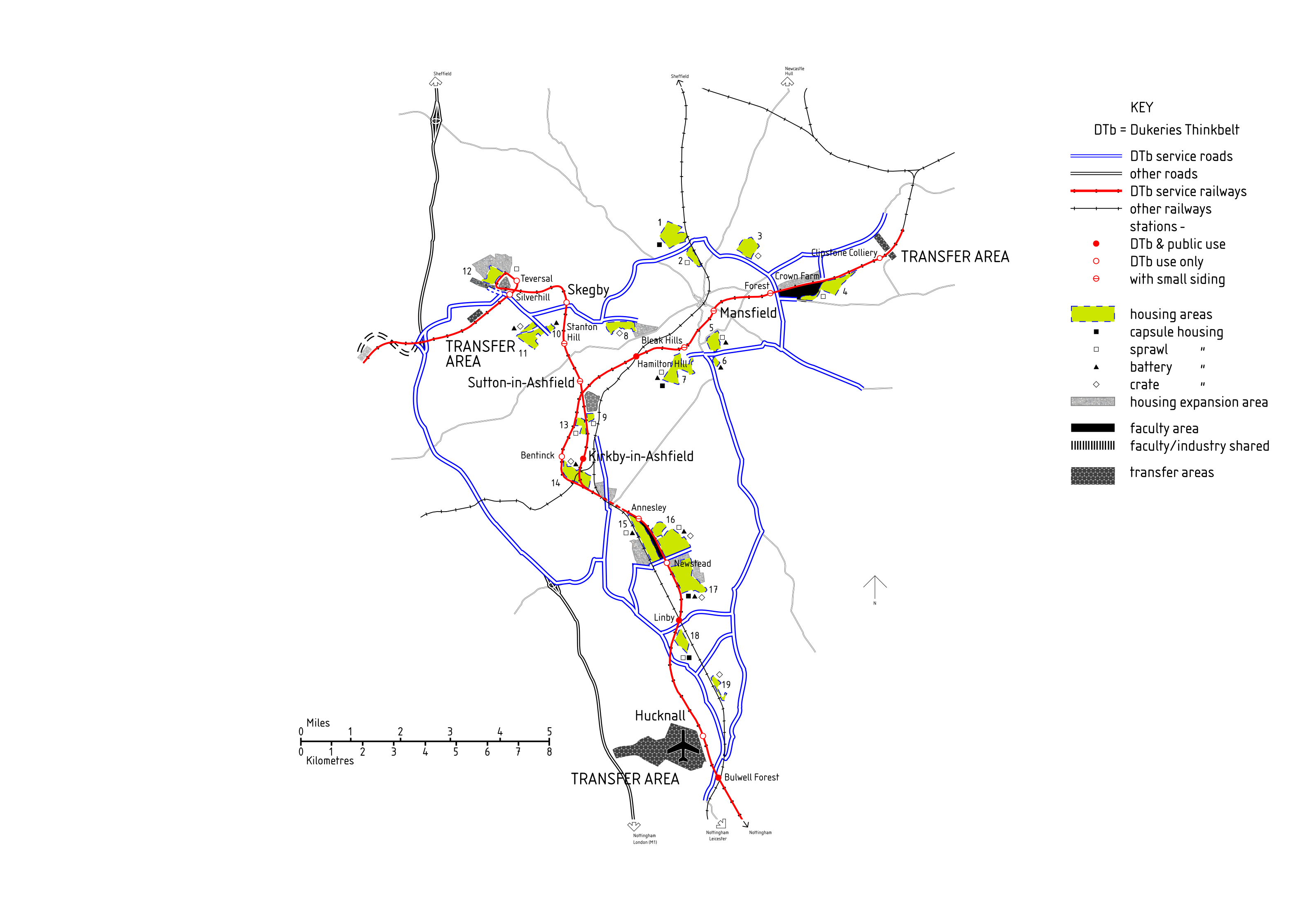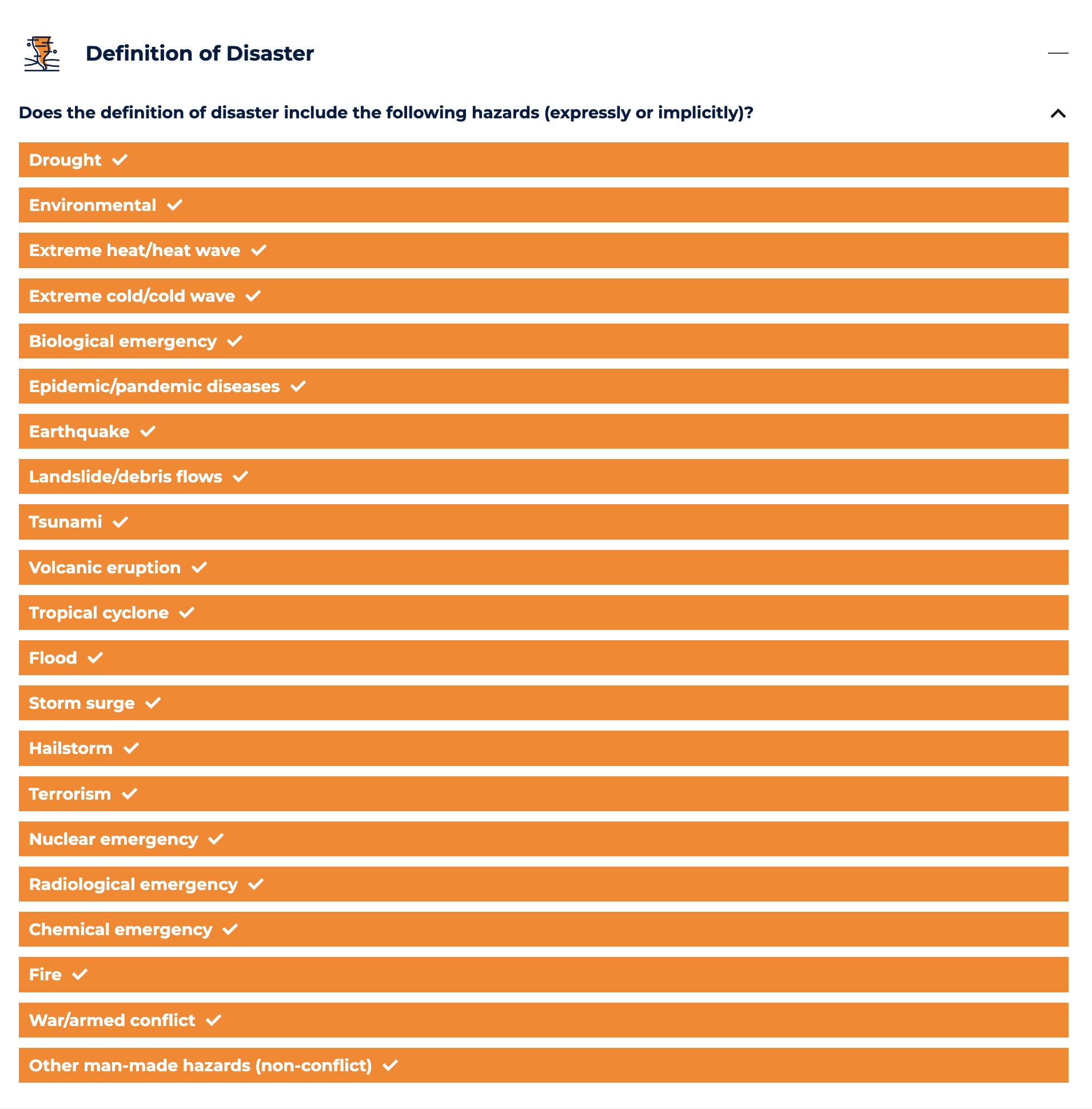Disaster Planning: Notts

|

|
• Maps indicating development in old industrial net between Nottingham and Sheffield (late forties). Sources: A.P. Nicholson.
- "...the information required by man to act in the present is contained in the long-term consequences of action, rather than in short-term known results."
- Hasan Ozbekhan (1971) 'Large Systems and their Regulation'.
|
• Table 1: UK 'Definition of Disaster'. Source: IFRC. Click image to view. The Federal Emergency Management Agency defines the term 'disaster' as:— |
[edit] FOREWORD
Thus this article is predicated on a known fact, namely:— |
[edit] INTRODUCTION
Using the FEMA definition of the term 'disaster', this article assumes:—
- ... that there is sufficient evidence available to define both the Beeching cuts and the Miners' strike as disasters.
For example:—
| "Out of 18,000 miles (29,000 km) of railway, Beeching recommended that 6,000 miles (9,700 km)—mostly rural and industrial lines—should be closed entirely, and that some of the remaining lines should be kept open only for freight. A total of 2,363 stations were to close, including 435 already under threat, both on lines that were to close and on lines that were to remain open." Wikipedia | "In 1983, Britain had 175 working pits, all of which had closed by the end of 2015." Wikipedia |
• Table 2: Known facts about the results of the Beeching cuts (left) and the Miners' strike (right).
In March 2024, Norman Fellows created two supplementary articles about the Beeching cuts and the Miners' strike, namely:—
- Beeching cuts: The railway network in Nottinghamshire
- Miners' strike: The coal industry in Nottinghamshire
Thus this article claims:—
- ... that two reports by Richard Beeching—i.e. 'The Reshaping of British Railways' (1963) and 'The Development of the Major Railway Trunk Routes' (1965)—led to severe damage to public property in the railway network in Nottinghamshire; and
- ... that a report by Nicholas Ridley—i.e. 'Report of Nationalised Industries Policy Group' (1977)—led to severe damage to public property in the coal industry in Nottinghamshire.
It also claims:—
- ... that a report by Cedric Price— i.e. 'Potteries Think Belt (sic): A plan for the establishment of a major advanced educational industry in North Staffordshire' (1966)—led to his proposal for “Possible Thinkbelt development in old industrial net between Nottingham and Sheffield 30-40 miles (i,e, half length of Los Angeles)” (1969).
However, the purpose of this article is therefore:—
- to establish a valid equation between contemporary social aspirations and architecture.
[edit] (1) The architectural legacy of Richard Beeching in Nottinghamshire.
This article assumes:—
- ... that Richard Beeching worked from a premise which prioritised economic aspirations; and
- ... that the Beeching reports perceived the architecture of the railway network in Nottinghamshire as expendable.
Tables 3 and 4 below indicate the extent of the damage to public property in the railway network in Nottinghamshire.
|
• Map indicating the closed Radford Junction - Shireoaks East Junction line. Source: Martin Firth. |
Radford Junction - Shireoaks East Junction
• Source: Martin Firth. |
• Table 3: Radford Junction - Shireoaks East Junction
|
• Map indicating the closed Nottingham (Victoria) - Woodhouse Junction line. Source: Martin Firth. |
Nottingham (Victoria) - Woodhouse Junction
• Source: Martin Firth.
n.b. This line crosses the Nottinghamshire/Derbyshire border between Kirkby Bentink and Tibshelf (Town) stations. |
• Table 4: Nottingham (Victoria) - Woodhouse Junction
[edit] (2) The architectural legacy of Nicholas Ridley in Nottinghamshire.
This article assumes:—
- ... that Nicholas Ridley worked from a premise which prioritised economic aspirations; and
- ... that the Ridley Report perceived the architecture of the coal industry in Nottinghamshire as expendable.
Table 5 below indicates the extent of the damage to public property in the coal industry in Nottinghamshire.
 • Map indicating Collieries in Nottinghamshire before the Miners' strike • Map indicating Collieries in Nottinghamshire before the Miners' strike
|
|
• Table 5: Collieries in Nottinghamshire open before the Miners' strike together with dates of closure
[edit] (3) The architectural legacy of Cedric Price in Nottinghamshire.
This article assumes, after the Canadian Centre for Architecture (CCA):—
- ... that Cedric Price worked from a premise which prioritised social aspirations and architecture; and
- ... that the Potteries Thinkbelt foreshadowed "Possible Thinkbelt development in old industrial net between Nottingham and Sheffield" (Non-plan, 1969).
Table 6 below indicates the continuing legacy of the Thinkbelt study.
|
• Panel. Source: A. Jacob Levin |
• Facsimile by Norman Fellows. |
• Table 6: Collages comparing the original conception in Staffordshire (left) with an iteration in Nottinghamshire.
The map of the Dukeries Thinkblet reproduced below shows proposed main routes, transfer, faculty and housing areas in more detail.
 • Site Plan of the Dukeries Thinkbelt ©© Norman Fellows. Click here to see on Google Maps
• Site Plan of the Dukeries Thinkbelt ©© Norman Fellows. Click here to see on Google Maps
[edit] CONCLUSION
(1) Firstly, the Beeching reports were supported with legislation. For example, according to Wikipedia:—
- The Transport Act 1962 dissolved the British Transport Commission (BTC), which had overseen the railways, canals and road freight transport and established the British Railways Board, which took over on 1 January 1963, with Dr Beeching as its first chairman. The Act put in place measures that simplified the process of closing railways by removing the need for the pros and cons of each case to be heard in detail. It was described as the "most momentous piece of legislation in the field of railway law to have been enacted since the Railway and Canal Traffic Act 1854".
- Wikipedia
Furthermore:—
- The Act put in place measures that enabled the closure of around a third of British railways the following year as a result of the Beeching report, as the Act simplified the process of closing railways removing the need for pros and cons of each case to be heard in detail.
- Wikipedia
Thus this article rejects the premises Beeching worked from and concludes firstly:—
- ... that the economic aspirations upon which the Beeching reports were predicated led to severe damage to public property in Nottinghamshire.
(2) Secondly, the Ridley report was not supported with legislation. For example, from the report itself:—
- "There is a strong case for avoiding legislation in the field of public industry as far as possible. Not only is legislative time scarce but it would stir up an unnecessary hornet's nest. The only necessary Bill would be one to end the public sector monopolies."
- (Ridley, p.13)
Furthermore, according to Wikipedia:—
- The Coal Industry Act 1987 (c. 3) changed the name of the National Coal Board (NCB) to the British Coal Corporation. With the passing of the Coal Industry Act 1994, the 16th and last Coal Industry Act, the industry-wide administrative functions of British Coal were transferred to the new Coal Authority from 31 October 1994.
- All economic assets were privatised.
- Wikipedia
Thus this article rejects the premises Beeching worked from and concludes secondly:—
- ... that the economic aspirations upon which the Ridley report was predicated led to severe damage to public property in Nottinghamshire.
In addition, the Ridley report also stated:—
- "There are whole towns dependent on steel works, coal mines and ports, which might be severely deprived if full efficiency policies are carried out. The responsibility for dealing with these is that of Government rather than the Industry."
and proposed three possibilities, namely:—
- "The Government can either refund the industry for the continuation of uneconomic plants for social reasons;
- or it can use its financial strength to bring in new industries;
- or it can compensate financially the victims of industrial change."
However, the Government did not do any of these possibilities.
(3) Thirdly, and in contrast to the Beeching and Ridley reports, the Cedric Price report did lead to a constructive proposal, namely:—
- "Possible Thinkbelt development in old industrial net between Nottingham and Sheffield 30-40 miles"
- (Cedric Price, Architectural Design, May 1969)
Thus this article accepts the premise Cedric Price worked from and concludes thirdly:—
- ... that the social aspirations upon which the Cedric Price report was predicated for North Staffordshire could be updated for West Nottinghamshire.
Work can start now on Dukeries Thinkbelt: A plan for the establishment of a major advanced educational industry in West Nottinghamshire.
[edit] References
Beeching, R. (1963) 'The Reshaping of British Railways - Part 1: Report', HMSO.
Canadian Centre for Architecture (2004) 'Potteries Thinkbelt', DR2004:0089, Canadian Centre for Architecture.
Canadian Centre for Architecture (2008) 'Cedric Price fonds', Canadian Centre for Architecture.
Designing Buildings Contributors (2020) 'Beeching cuts', Designing Buildings.
Federal Emergency Management Agency (1996) 'Glossary of Terms', FEMA.
Firth, M. (2024) 'Register of Closed Railways', registerofclosedrailways.co.uk
HM Government (1946) 'Coal Industry Nationalisation Act 1946', legislation.gov.uk
HM Government (1947) 'Transport Act 1947', legislation.gov.uk
Levi, A. J. (2011) 'Potteries Thinkbelt – Education, Architecture and a Way Foward', Sputnik Shuffle.
Norman Fellows (2024) 'Beeching cuts: The railway network in Nottinghamshire', Designing Buildings.
Norman Fellows (2024) 'Miners' Strike', Designing Buildings.
Norman Fellows (2024) 'Miners' strike: The coal industry in Nottinghamshire', Designing Buildings.
Ozbekhan, H. (1971) 'Large Systems and their Regulation', in Architectural Design, November 1972.
Cedric Price (1969) 'Non-Plan', Architectural Design, May.
Ridley, N. (1977) 'Report of Nationalised Industries Policy Group', Margaret Thatcher Foundation.
Wikipedia Contributors (2023) 'Transport Act 1947', Wikipedia.
Wikipedia Contributors (2023) 'Transport Act 1962', Wikipedia.
Wikipedia Contributors (2024) '1984–1985 United Kingdom miners' strike', Wikipedia.
Wikipedia Contributors (2024) 'Beeching cuts', Wikipedia.
Wikipedia Contributors (2024) 'British Coal', Wikipedia.
Wikipedia Contributors (2024) 'British Rail', Wikipedia.
Wikipedia Contributors (2024) 'Coal Industry Nationalisation Act 1946', Wikipedia.
Wikipedia Contributors (2024) 'National Coal Board', Wikipedia.
Wikipedia Contributors (2024) 'History of rail transport in Great Britain 1948–1994', Wikipedia.
[edit] Further reading
• Screenshot showing 064 Search results - click to view. Source: Norman Fellows
Norman Fellows (2024) '064 Search results', Google Drive.
Hardingham, S. (ed.) (2016) 'Cedric Price Works 1952–2003: A Forward-minded Retrospective', goodreads.com
Cedric Price (1966) 'Potteries Thinkbelt', New Society, 2 June, on Wordpress.
Cedric Price (1966) 'Potteries Thinkbelt', October, Architectural Design, on Wordpress.
Cedric Price et al. (1969) 'Non-Plan', 21 March, New Society.
Cedric Price (1969) 'Non-Plan', May, Architectural Design.
Cedric Price and the Architectural Association (1984) 'Cedric Price: Works II', goodreads.com
Cedric Price and Isozaki, A. (1999) 'Re:CP', goodreads.com
Cedric Price (1999) 'Message (fax) from Cedric Price addressed to the IFCCA Prize Coordinator', IFPRI records, Canadian Centre for Architecture.
Rattenbury, K. (ed.) and Hardingham, S. (ed.) (2008) 'Supercrit #1 Cedric Price: POTTERIES THINKBELT', goodreads.com
[edit] Related articles on Designing Buildings
Featured articles and news
Amendment to the GB Energy Bill welcomed by ECA
Move prevents nationally-owned energy company from investing in solar panels produced by modern slavery.
Gregor Harvie argues that AI is state-sanctioned theft of IP.
Heat pumps, vehicle chargers and heating appliances must be sold with smart functionality.
Experimental AI housing target help for councils
Experimental AI could help councils meet housing targets by digitising records.
New-style degrees set for reformed ARB accreditation
Following the ARB Tomorrow's Architects competency outcomes for Architects.
BSRIA Occupant Wellbeing survey BOW
Occupant satisfaction and wellbeing tool inc. physical environment, indoor facilities, functionality and accessibility.
Preserving, waterproofing and decorating buildings.
Many resources for visitors aswell as new features for members.
Using technology to empower communities
The Community data platform; capturing the DNA of a place and fostering participation, for better design.
Heat pump and wind turbine sound calculations for PDRs
MCS publish updated sound calculation standards for permitted development installations.
Homes England creates largest housing-led site in the North
Successful, 34 hectare land acquisition with the residential allocation now completed.
Scottish apprenticeship training proposals
General support although better accountability and transparency is sought.
The history of building regulations
A story of belated action in response to crisis.
Moisture, fire safety and emerging trends in living walls
How wet is your wall?
Current policy explained and newly published consultation by the UK and Welsh Governments.
British architecture 1919–39. Book review.
Conservation of listed prefabs in Moseley.
Energy industry calls for urgent reform.






























